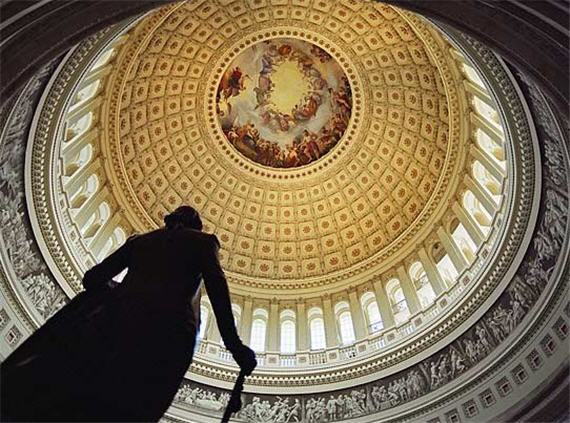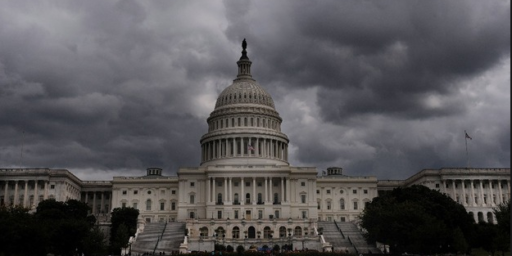38% Of Congressmen Represent “Safe” Districts
Chris Cillizza passes along some facts that explain a lot about why the House of Representatives is in the state it is currently in:
Looking for the roots of the current morass in Washington? Look no further than the chart — built by the WaPo graphics wizards — below that shows the percentage of the vote that all House Members won with in the 2012 election.
The math is stark. Of the 199 Democrats in the House at the start of the 113th Congress, a majority — 51 percent(!) — won their race with 67 percent of the vote or higher. Among the 234 Republicans elected in the last election, 67 — or roughly 29 percent of the GOP conference — won with 67 percent or higher.
Add it up and you have 168 seats in which the current incumbent won with 67 percent or more of the vote. That’s 38 percent of the entire House with virtually no concern about losing a general election.
Those numbers are even more remarkable when stood against the paltry group of seats that are genuinely competitive between the parties. In the 2012 election just 31 Republicans and 31 Democrats won their seats with 54 percent of the vote or less — just 14 percent of the entire House.
In short: There are almost three times as many members elected with 67 percent or more as there are elected with 54 percent of the vote or less. Given that data, it shouldn’t be surprising to anyone that the incentive to cooperate with the other side and find bipartisan solutions is almost nil.
This is a phenomenon I’ve touched upon before, most recently yesterday. In another post, I noted the fact that the steep drop off in the number of swing districts — from 103 in 1992 to just 35 in 2012, drop of some 66% in just 20 years — has contributed to political gridlock. Of course, high re-election rates for incumbents has been a long term historical fact even when there were fewer “safe” seats. In 2012, for example, 90% of House incumbents and 91% of Senate incumbents who sought re-election were successful. Members of Congress notice these things, of course, and since the biggest form of feedback that they get are election results, the fact that they are consistently re-elected, quite often by huge margins, tells them that they’re doing just fine. As long as that’s the case, it’s unlikely that many on Capitol Hill are going to change their behavior.







This weekend I listened to an interview with Dan Balz of the Washington Post go over these numbers too. Dan noted that we’re polarized back to post Civil War Reconstruction Era levels. Frankly, I don’t see how this changes anytime soon.
Unless the public all of sudden becomes smart, there will be no electoral consequences for shutting down the government and causing a default. Well perhaps it means that The House doesn’t change, and the GOP gains fewer senate seats than they otherwise might – even so, I have no confidence there either. The 2016 presidential race is still too far out there for me to guesstimate.
I find it interesting that more democrats had safe seats than GOP meme era but whenever discussions of gerrymandering come up the focus is all about how the awful, insane republicans are in safe districts with crazy constituents but not much mention is made of the safe democrat seats.
I think there is a lot of polarization in the US but it is more of a rural/urban divide than anything else.
@Just Me:
Pretty sure the super safe Democratic seats are a result of Republican gerrymandering. Also, those representatives aren’t demanding anything crazy in return for not tanking the economy.
The rural/urban divide just means it’s easier for the GOP to gerrymander effectively.
@Just Me:
You seem to not understand that the Democrats having a bunch of insanely safe districts is exactly what Republican gerrymandering would result in? The entire purpose of gerrymandering is to cram as many democrats into as few districts as possible. In which case, the Democrats will win those districts 90/10, and then the Republicans can take the rest of the districts by lower 60/40 and 55/45 margins. That is how Gerrymandering works. Having most of your party’s voters crammed into 90% Democrats districts is BAD for Democrats. It’s wasted votes.
There are two things going on here: gerrymandering and urban/rural. Even w/o gerrymandering, the Dems would have more concentration, and thus have fewer seats than you might expect if you just looked at vote totals.
As I recall, somebody crunched the numbers on this after the 2012 election and figured that in a non-gerrymandered (or gerrymandered but without the 2010 redistricting, maybe) the Dems would have won more seats but the GOP would still have a majority in the House.
Look at Pennsylvania. The Democrats got 50.28% of the votes for the House but ended up getting only 5 of 18 seats, that’s 28%.
In the districts won by Democrats, the Democrat got 89.3%, 84.9%, 69.1%, and 60.3% of the votes.
In the districts won by Republicans, the Republican got 51.7%, 54.8%, 54.8%, 56.6%, 56.8%, 57.1%, 58.5%, 59.4%, 59.7%, 61.7%, 62.9%, 64.0% and 65.6%.
So, that would be three Democratic safe seats according to WaPo’s definition and no Republican safe seats.
The 67%+ safe seats are created by gerrymandering and by the fact that Democrats are a lot more urbanized than Republicans.
@PJ:
I think you’re missing one of the Democratic seats (likely PA-2, where a Democrat winning less than 90% of the votes is an upset).
@Moosebreath:
Thanks, I missed PA-14, where the Democrat won with 76.9%.
In PA-2, the Democrat “only” won with 89.2% of the votes… 😉
@PJ:
“In PA-2, the Democrat “only” won with 89.2% of the votes”
What did Fattah do to let it be that competitive?
I’d appreciate a deeper dig. Where people win the general election by 20%+ margins are they supported by a unified, homogenous bloc? Taegan Goddard’s blog linked to a survey yesterday that broke down the GOP side of this thing anyway, as unified now but not homogenous. It was something like 55% evangelicals/social conservatives, 25% tea party/libertarian, and the rest moderates. Another area to dig into is how the mix varies between parties, and across safe and unsafe districts.
Here in Illinois Democrats have complete veto-proof control of the state legislature and the governor’s mansion. Look at a map of Illinois’s congressional districts. The most gerrymandered of the districts drawn by the state’s Democratic leadership are either a) ethinic/racial minorities or b) Republicans.
So, for example, the 4th Congressional district is roughly horseshoe-shaped and concentrates Chicago’s Hispanic vote into a single district. That district sends Luis Guitierrez to Congress.
Another horseshoe-shaped district is represented by Republican Bobby Shilling.
The purpose of gerrymandering is pretty obvious: to prevent challenges to incumbents and ensure that Democratic districts are overwhelmingly Democratic and Repubican districts are overwhelmingly Republican while ensuring that most incumbents don’t need to deal with issues that are of importance to racial/ethnic minorities.